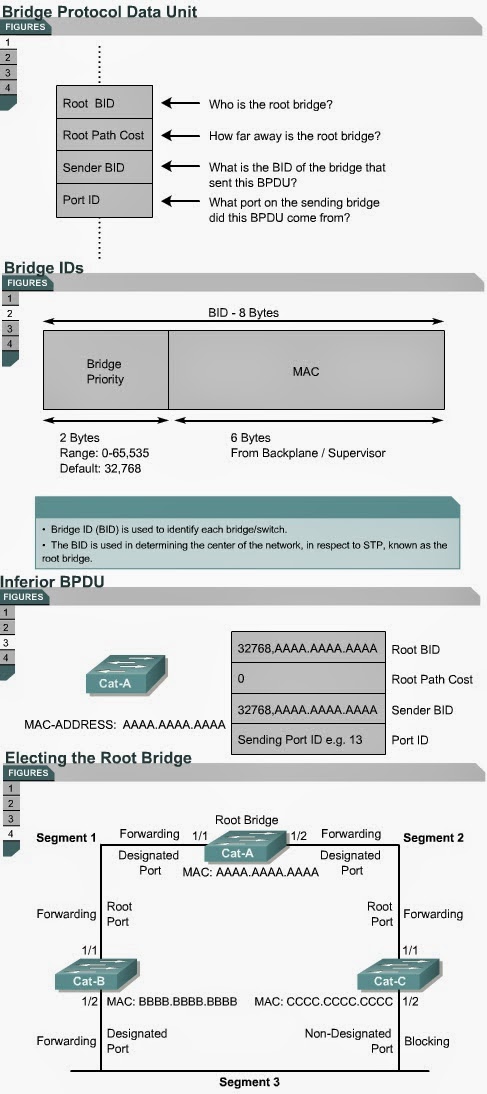Selecting the root bridge
7.2.4 This page will explain how a root bridge is selected in an STP
network.
The first decision that all switches in the network make, is to
identify the root bridge. The position of the root bridge in a network affects
the traffic flow.
When a switch is turned on, the spanning-tree algorithm is used to
identify the root bridge. BPDUs are sent out with the bridge ID (BID). The BID consists of a bridge priority that
defaults to 32768 and the switch MAC address. By default BPDUs are sent every two seconds.
When a switch first starts up, it assumes it is the root switch and
sends BPDUs that contain the switch MAC address in both the root and sender
BID. These BPDUs are considered inferior because they are generated from the
designated switch that has lost its link to the root bridge. The designated
switch transmits the BPDUs with the information that it is the root bridge as
well as the designated bridge. These BPDUs contain the switch MAC address in
both the root and sender BID. The BIDs are received by all switches. Each
switch replaces higher root BIDs with lower root BIDs in the BPDUs that are
sent out. All switches receive the BPDUs and determine that the switch with the
lowest root BID value will be the root bridge. Network administrators can set the switch
priority to a smaller value than the default, which makes the BID smaller. This
should only be implemented when the traffic flow on the network is well
understood. The Lab Activities will teach students how to select the root
bridge for a basic switch configuration. The next page will discuss the STP
port states.
Stages of spanning-tree port states
7.2.5 This page will explain the five port states of a switch that uses
STP.
Time is required for protocol information to propagate throughout
a switched network. Topology changes in one part of a network are not instantly
known in other parts of the network due to propagation delay. Data loops can
occur when a switch changes the state of a port too quickly.
Each port on a switch that uses the Spanning-Tree Protocol has one
of five states, as shown in Figure  .
In the blocking state, ports can only receive BPDUs. Data frames
are discarded and no addresses can be learned. It may take up to 20 seconds to
change from this state.
Ports transition from the blocking state to the listening state.
In this state, switches determine if there are any other paths to the root
bridge. The path that is not the least cost path to the root bridge returns to
the blocking state. The listening period is called the forward delay and lasts
for 15 seconds. In the listening state, data is not forwarded and MAC addresses
are not learned. BPDUs are still processed.
Ports transition from the listening state to the learning state.
In this state, data is not forwarded, but MAC addresses are learned from
traffic that is received. The learning state lasts for 15 seconds and is also
called the forward delay. BPDUs are still processed.
Ports transitions from the learning state to the forwarding state.
In this state user data is forwarded and MAC addresses continue to be learned.
BPDUs are still processed.
A port can be in a disabled state. This disabled state can occur
when an administrator shuts down the port or the port fails.
The time values given for each state are the default values. These
values have been calculated on an assumption that there will be a maximum of
seven switches in any branch of the spanning-tree from the root bridge.
The Interactive Media Activities will help students learn the five
spanning-tree port states.
.
In the blocking state, ports can only receive BPDUs. Data frames
are discarded and no addresses can be learned. It may take up to 20 seconds to
change from this state.
Ports transition from the blocking state to the listening state.
In this state, switches determine if there are any other paths to the root
bridge. The path that is not the least cost path to the root bridge returns to
the blocking state. The listening period is called the forward delay and lasts
for 15 seconds. In the listening state, data is not forwarded and MAC addresses
are not learned. BPDUs are still processed.
Ports transition from the listening state to the learning state.
In this state, data is not forwarded, but MAC addresses are learned from
traffic that is received. The learning state lasts for 15 seconds and is also
called the forward delay. BPDUs are still processed.
Ports transitions from the learning state to the forwarding state.
In this state user data is forwarded and MAC addresses continue to be learned.
BPDUs are still processed.
A port can be in a disabled state. This disabled state can occur
when an administrator shuts down the port or the port fails.
The time values given for each state are the default values. These
values have been calculated on an assumption that there will be a maximum of
seven switches in any branch of the spanning-tree from the root bridge.
The Interactive Media Activities will help students learn the five
spanning-tree port states.





